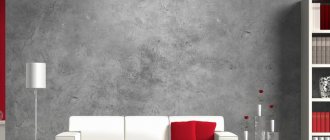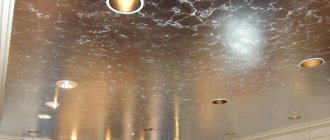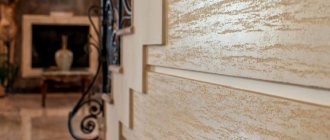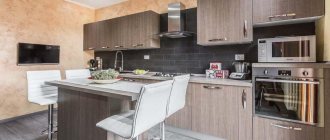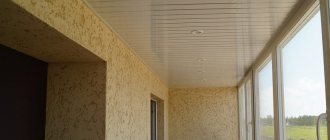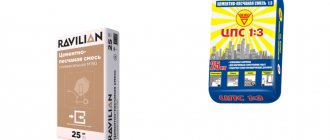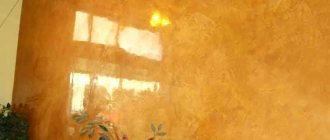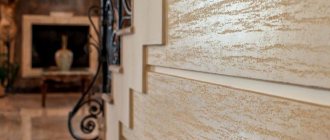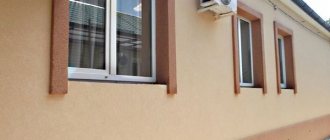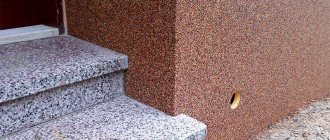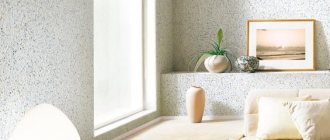Home » Decor » Wall decoration
Wall decoration
Alyona
66605 Views
Decorative plaster can radically transform a home. Moreover, it can be combined with other types of cladding, painted in different colors, and any structures can be used.
Varieties by composition
Floral patterns, ceiling stucco, antique stonework, Venetian, large waves - all this and much more can be created from textured plaster.
Decorative plaster can radically transform a home
The material goes on sale not only in white, but also in any other color, in dissolved form or in the form of dry mixtures. Each type has its own composition, preservatives, and fillers. The appearance of surfaces depends on them.
The structural nature of the coating makes it possible to create different patterns and effects. It doesn’t matter whether it’s a ceiling or a wall, a bathroom or a kitchen, a living room or a bedroom, a nursery or a hallway. Color or combinations thereof, texture or pattern are the exclusive prerogative of the master who works with the mixture. The main thing is that everything is combined with the style, and does not look pretentious and provocative. Based on their composition, the following types of textured plaster are distinguished:
Mineral
Mineral - most often used in the kitchen and bathroom
It is based on cement and is sold in powder form. Endowed with excellent resistance to moisture, suitable for any surface. Can be used in the kitchen and bathroom.
Silicone
Silicone - easy to lay on any surface
This is a ready-to-use mixture and does not need to be diluted. fits well and easily on absolutely any surface, be it wallpaper under plaster, old uneven walls or brick. It has good moisture resistance, suitable for corridors, halls, bathrooms or kitchens. It can be used even on unprepared surfaces.
Acrylic
Acrylic - has good coverage
Liquid material, can be used immediately after opening the package anywhere. It has uniquely good covering ability and high decorative properties. Recommended for decorating living rooms, bedrooms, and children's rooms. The advantage of this material is a wide range of colors. Polymer plaster is similar to this type.
Silicate
Silicate – contains liquid glass
Also available in ready-to-use form. Contains liquid glass. Has excellent adhesive properties. It fits well and masks unevenness. Can serve as a basis for structural types of plaster.
Silicate-based coatings
This coating is used for finishing exclusively external walls and surfaces, due to the presence of “liquid” glass and a number of other harmful impurities in the composition.
Silicate coatings can be found on sale in finished form. But it should be remembered that the applied coating dries very quickly, and therefore it is necessary to work with the proper amount of skill.
Textured varieties
Any type of decorative plaster can be used to create a smooth surface or act as a material for creativity. They are used to make relief compositions and patterns, from simple to the most complex, including panels for decoration.
Graphito
Graphite – contains sand (sand concrete)
Thin-layer concrete containing sand (sand concrete). It can be used to create wood coverings, porcelain stoneware, leather, decorative stone and fabric. It is also used to create volumetric or floral motifs. Even monumental images can be recreated from it . The material is very good for decorating walls in the medieval style.
Flock
Flock - very popular plaster
Decorative finishing designed to recreate a soft structure similar to natural fabric. Very popular. It is used to decorate children's rooms, bedrooms and other rooms where a warm atmosphere and comfort is considered a priority. The mixture consists of multi-colored acrylic flakes. This is the main feature of flock plaster. With it, you can alternate areas of different colors with each other. In this case, no joints are formed, the coating looks solid. This feature of flock plaster allows you to decorate, for example, children’s rooms in different colors easily and naturally.
Venetian
It is considered the queen among other types of plaster. Most designers use it in their projects. It is used to imitate translucent marble tiles, rocks and other textures. The composition of this mixture has a unique visual depth. It is suitable for any premises:
- children's;
- living rooms;
- hallways;
- kitchens
It can be combined with your favorite other materials and finishes.
Marble slab covering is a unique solution, especially in areas with curvature. This type of finishing is called classic because our ancestors and others used marble chips and lime. They were often used in the Middle Ages.
Advice If you cover the Venetian with a wax coating on top, then this lining will last at least 10 years, or even longer.
Stone chips
Stone chips are a cladding method that also deserves attention
I believe that this method of cladding also deserves attention. Stone chips from fine to medium fraction (0.5-5 mm) in a special binder can work wonders. The manufacturer can use marble, granite or quartz as the base (stones). This coating can be stylishly finished:
- arched openings;
- corners;
- niches;
- architectural elements.
The clear, cold appearance of the coating in combination with another type looks simply gorgeous.
Bark beetle
A pleasant atmosphere will always reign in a room covered with bark beetle.
Despite the fact that bark beetle is used mainly for finishing facades, it can also be found among passers-by in some apartments. In a room covered with bark beetles, a pleasant atmosphere will always reign, conducive to relaxation and tranquility. The coating is endowed with high strength indicators, lasts a long time, and does not lose its original appearance throughout its entire service life. practicality, durability. I can say that those who use it are chasing two birds with one stone and successfully catching up with both.
Africa
Africa looks quite expensive
Covering imitating snake or crocodile skin. Possessing a special decorative effect, it is often used in interior decoration, emphasizing the ethnic flavor. It looks quite expensive. The top is covered with glitter, paint or wax.
Marseille wax
Option with Marseille wax
Used by designers to create a rocky, antique masonry or sandstone look. The color scheme is light sand. Such elements complete the interior, adding coziness and warmth to the room. It is usually used to decorate doorways or certain sections of walls.
Silk effect
An amazingly beautiful type of plaster, reminiscent of silk with unobtrusive designs and patterns. They look chic in the interior and give a rich tactile sensation to the touch.
Silk plaster is considered the queen in the decorative plasters sector. It always looks expensive, chic, aristocratic, no matter where it is used. A special charm is the shimmer of rays in daylight, from which it is difficult to take your eyes off.
Decorative plaster differs from traditional plaster in that it contains substances that give the coating uneven, decorative shapes and textures. Manufacturers use as a basis:
- quartz;
- foil;
- mica;
- silk fibers.
They are the ones who recreate beautiful patterns on wall surfaces. Both will add dynamism to the interior. Will radically change the appearance. Will make the room truly stylish.
Gypsum plaster
The dry composition of gypsum plaster consists of gypsum powder with polymer additives and fillers, which determines the scope of application of the mixture for interior work.
The material does not tolerate changes in humidity and temperature, maintaining its integrity at room temperature and humidity, and is applied to different substrates.
Color of personal choice and style
Accentuation is the most famous and most important design technique that always plays a win-win game. Especially then, the task is not only to refresh the room, but also to make it stylish, fashionable, and add a touch of sophistication and wealth. The choice of colors here comes second to the choice of material. Color is the mood, emotions and impressions that a person receives from the renovation.
The choice of color affects mood, emotions and impressions
It should be in harmony with the style, not irritate, not tire. The fundamental choice of color palette is based on four groups:
- Fresh. They give transparency, purity and spirituality.
- Warm. They calm loved ones, and add coziness to the room, making them ready to relax.
- Saturated. They have a high percentage of coloring matter.
- Calm. Soft colors, most often with shades of gray. This decision brings balance and peace to the home.
The color should be in harmony with the style, not irritate, not tire
Market prices. Comparison table of popular options
| Name | Type by base | Price |
| Ceresit Bark beetle | silicone | from 4900 rubles for 25 kg |
| Weber-Vertonit | acrylic | from 2100 rubles for 25 kg |
| VGT Sea Breeze | silicate | from 3200 rubles for 25 kg |
| Venetian plaster BADIGEON | acrylic | from 1200 rubles for 2.5 liters |
| Caparol Stucco Satinato Wet silk | polymer | from 9000 rubles for 5 liters |
And in order to correctly calculate the required amount of material for wall finishing, a plaster consumption calculator will help you.
How and what kind of plaster can be used in kitchens?
By making a revolution in the kitchen and bathroom, refusing to glue wallpaper for painting and ceramic tiles, you will make them super fashionable, stylish and unique. This room is considered to have an extreme climate in the house, so for the kitchen it is advisable to choose acrylic-based synthetic compositions. Only they are able to withstand temperature changes, are resistant to the formation of fungal formations, and allow air to pass through well.
Advice It is advisable to cover the top layer with wax or paint, this way it will last longer without losing its appearance and will simplify the care of the coating.
In the interior of the kitchen
Look at the photo to see how your kitchen or bath can be transformed if you choose decorative plaster as a finish. And it doesn’t matter what it will be:
- Venetian silk;
- bark beetle;
- velvet, classic travertino;
- marble;
- microcement.
Gypsum mixtures cannot be used as a base for these rooms. They are afraid of high humidity and do not meet hygienic requirements. Because they actively absorb moisture, they swell, losing their integrity. In order not to have to redo the repairs, and in the near future, you simply need to abandon them.
Venetian decorative plaster is especially popular in kitchen decoration.
It is used to create styles such as:
- Mauritanian;
- high tech;
- country;
- vintage;
- retro.
Here they use discreet smooth textures.
- The Venetian looks good in combination with an exquisite panel and a white set. The coating can be applied to all four walls or to individually selected sections.
- An option where the ceiling surface in the kitchen will not be flat, but textured, and the walls will be smooth, one-color or two colors, will look creative. Here the color of the headset is selected according to personal preferences. You can even recreate imitation clouds or painting motifs on the ceilings.
- It would be interesting to look at the option where such a coating separates the working area from the dining area.
- The combination of a decorative brick-like coating with a smooth surface also looks original. Such a kitchen will look impressive and stylish.
- The photo shows what a combination of artificial stone and bark beetle looks like in a small kitchen. You can choose any colors, not just those used for the example.
- Concrete plaster is often used in kitchens. It looks quite decent and original. In the apron area, you can use transparent or mirror wall panels. They will not spoil the overall appearance and will serve as reliable protection for the coating.
- You can leave the same color as concrete. True, strokes of different shades will look even better on deep gray, for example, black, white or strokes of whitish hairs, with shades of rust or a metallic sheen.
There are a lot of options for using textured coatings. They can be used to decorate only arches, niches, ledges or all walls along with these architectural elements. You can make them plain or combine colors.
Little tricks in kitchen design
I hope these tips will help you in decorating your kitchen space:
- If the kitchen has niches, ventilation ducts, or openings, decorate them with patterned plaster.
- If you have a fireplace or stove in your house, cover them with brick or natural stone plaster; in addition to an aesthetic and fashionable appearance, you will achieve another effect - under such a coating the chips and cracks on them will be hidden.
- If you want to make a kitchen in a maximalist style, use a smooth wall covering.
- If your kitchen is light and spacious, and the furniture set is exclusive, use Venetian plaster in your work.
There are many options for using coatings
The apron is especially susceptible to temperature changes, so it can be covered with ceramic tiles. Cover the dining area with decorative plaster as much as possible, this will add comfort.
Pollution
In photos of wall plaster, it usually looks clean and white, but many types of it simply attract all sorts of dust and dirt.
This problem can be solved by first varnishing or waxing the surface of the wall. This must be done before using the plaster.
Use in the hallway
The corridor, hallway, and hall are considered, if not the main ones, then at least important in the house. They are called a showcase that introduces guests to the apartment, style tastes and preferences of the owners. Therefore, it must be formalized with dignity and correctly. This is how guests form their first impression.
Use of material in the hallway
- Smooth, patterned surfaces that subtly cover the walls are best for a small hallway.
- To visually enlarge the space, it is better to take as a basis decorative plaster of light colors with a smooth or finely granulated texture and a discreet design or pattern in the center.
- Any relief visually creates volume, so a small area of the room will be hidden.
- In combination with the Venetian, you can use gold-colored stucco, however, if this does not contradict the style of the project.
- For large hallways and halls, I recommend choosing Venetian. This way your space will sparkle in a new way, it will look not like an ordinary room, but like a real palace or a main entrance.
- Plaster that imitates brickwork or decorative stone looks gorgeous in the corridors.
- For interiors in the pop art style, three-dimensional drawings made in bright colors are best suited.
- Picturesque paintings, against the backdrop of decorative plaster, will complement the image and add elegance to the classic style.
- The delicate colors of textured plaster walls are the best way to enliven a Provencal-style hallway.
- The Venetian with the effect of wet silk looks gorgeous in the interior of the corridor. It can be safely combined with glass, wood or metal.
Corridors and hallways are deprived of a source of natural light, so they need to use a light palette and bright colors. It would also be correct to use mirrors in them, especially if they have a small usable area.
Natural, muted tones will help create an atmosphere of peace and tranquility in living rooms and corridors.
What are the walls used for plastering?
The brick wall is treated with cement-based solutions, sometimes with the addition of lime. If the layer thickness is more than 20 millimeters, you should use a mesh for plastering the walls to avoid collapse.
To obtain a solution, a mixture of cement and sand in a ratio of 1:3-5 is gradually poured with water until the consistency of the dough is achieved. For limestone mortar, add 7 parts sand and 3 parts milk of lime to 1 part cement.
Proper plastering of interior walls made of facing bricks is very energy-intensive and requires special equipment, so it is better to leave this type of finishing in the hands of professionals.
A smooth concrete wall is treated with a solution of lime and gypsum in a 4:1 ratio. Pour gypsum into the water in a thin layer and knead until a not very thick mixture is formed.
Then lime and quartz particles are added.
An uneven concrete wall does not need the addition of quartz and can be plastered with either cement or gypsum mortar.
Foam concrete walls should first be treated with a primer, and then they can be plastered with gypsum solutions.
Choosing the right plaster is very important, so it is always better to consult a professional in this matter. An experienced seller can advise you on the most suitable option from those described above or offer to purchase a ready-made mixture.
Ways to decorate living rooms
Here, when planning renovations, we set ourselves two main tasks - to create comfort and convenience, conducive to rest and relaxation. Apparently, this is why the choice of finishing material for wall surfaces is a very important and difficult task.
- Decorative plaster in a living room design project may well serve as the main finish. It can also be combined with stone panels, wood, and paintable wallpaper.
- Here is a living room, where not only the wall surfaces are plastered, but also the ceiling, framed with stucco. No one can argue with the fact that it looks original and chic.
- If the goal is to visually increase the usable area, then you should use a mixture of light colors, even better with a good reflective effect.
- With Marseilles wax plaster you can create the following ornaments and imitation of wooden coverings, as well as imitation of brickwork and stone.
- To recreate an elegant, sophisticated living room interior, we choose Venetian plaster with a silver or golden sheen.
Velvet and silk walls reflecting particles of light flows look elegant and rich.
- Graphite is very often used by both designers and users. This type of plaster allows you to create the texture of aged walls or applications. The living room will also look good in certain areas.
- Africa is a widely known type of decorative plaster with a texture reminiscent of crocodile or snakeskin. It will look good and appropriate in an ethnic style living room. This finish looks expensive, especially if it is topped with a layer of glitter, varnish or wax.
- Rustic with the texture of shabby stone is used in the design of living rooms created in a country or historical style.
- Your living room will only benefit if you decorate the ceiling with patterns and combine walls with decorative plaster with areas covered with wallpaper for painting.
- You can artificially age walls using craquelure or bark beetle plaster. Cracks and abrasions are relevant in classic and retro styles.
The combination of several types of coverings in the living room does not make it pretentious and provocative if you correctly combine the colors and choose the texture.
I would like to note that traditional monotonous design projects, where the living room walls are made in gray tones, have long gone out of fashion.
Tip If you want your living room to look fashionable and beautiful, give preference to bright colors and new textures.
DIY apartment renovation
Of course, it’s easier for those who decide to renovate their apartment themselves. They say they are a “jack of all trades.” Where to start? If you decide to carry out a major overhaul, you need funds and great patience.
If you decide to carry out cosmetic repairs, then the costs here are different. And most importantly, your desire to update something and get joy from the work done is great.
But no matter what type of repair you choose, you need to make an effort, and most importantly, desire. And now the decision has been made. Decorative plaster and most importantly better than the neighbor's.
How can you decorate your bedroom beautifully?
Finishing the walls and ceilings of the bedroom is not only a way to extend the “life” of the coating as long as possible - it is a way to create a comfortable environment in it, conducive to relaxation before bed. Most often, flock plaster in dark or muted tones is used in such rooms.
Finishing bedroom walls and ceilings
- To create a volumetric effect, it is better to choose a material with medium or large fractions.
- Venetian is the ideal covering for a classic-style bedroom. With its help you can recreate the natural structure and appearance of natural stone. The naturalness of the color and the smoothness of the lines help to calm down and inspire serenity.
- The easiest way to get a trendy concrete wall surface is to use a ready-made concrete surface. White concrete walls are an interesting solution, but not everyone has this ready-made concrete wall. You can create a similar effect yourself if you use special plaster. It is no different from traditional concrete with all its characteristic structural effects. Such a coating can have any texture, be satin, matte, uniform, or imitate formwork.
In the bedroom interior
Venetian marble slab in rich bright green color is a bold decision.
- A win-win option, in my opinion, is a coating that imitates fabric. It can be velvet, wet silk, aged velvet or velor. The texture can be either matte or glossy. As for colors, the choice is up to the owners.
- The pistachio-colored bedroom looks original.
- A win-win option, and this has been verified, is the use of decorative plaster in natural shades.
- With Mann coating, walls can be made smooth or look like decorative stone. The roughness of the coating here is given by marble chips.
- Light shades of the coating can be complemented by shimmer by adding pearlescent pigment.
- With wet silk plaster you can create elegant design projects. It will give the walls a smooth and velvety feel.
- If you cover the walls with latex paint, then iridescent stains of a rich color palette will form on their surface. This bedroom will look even more beautiful.
Ideal cover for a classic style bedroom
- With Marseilles wax you can decorate the walls to resemble the bark of wood, stones or bricks, if you are satisfied with this design. And by covering the walls on top with wax, you can get a glossy look.
- An accent area in the bedroom is a common and quite fashionable solution. It is not at all necessary to use the same texture. For emphasis, choose the wall at the head of the bed. This changes the room radically.
Recommendations from professionals
- Alabaster should not be used to seal cracks; the plaster mixture perfectly eliminates all imperfections;
- It is necessary to do a test to ensure that the entire composition of the plaster mixture is in the same tone;
- The need to comply with the invoice;
- The first layers need to be moistened for about a week, only then apply the last layer.
- In order to make the room original and beautiful, the master needs a little time and desire. Having design ideas can always be translated into reality using ready-made materials.
Tips for beginners
If you decide to plaster the walls yourself with textured mixtures, I suggest you listen to the advice of professionals:
If you do not have experience working with this material, choose simple types of plaster; you can apply relief designs using stencil rollers. They can be bought at any construction market.
Unusual living room design in purple
- In plaster bark beetles, use special granules in your work. Move them in the desired direction with spatulas.
- To create bas-reliefs, stucco moldings, and three-dimensional decorative figures, use gypsum compositions, provided that you can do this. Otherwise, you can buy ready-made ones. There are plenty of them in hardware stores too.
- If up to this point you have no experience and have never worked with decorative plaster, try your strengths and capabilities on an inconspicuous section of the wall of a balcony, loggia or toilet.
In dark, neutral colors
Consider the features of your walls. Textured plaster fits well and without problems on surfaces made of brick or concrete without prior preparation.
- Consider the climate conditions of the room. For example, you can buy any type of covering for the living room, corridor or bedroom. And in the bathroom or kitchen, where the climatic conditions are unstable, pay attention to silicate mixtures. By the way, they can be periodically updated and repainted.
- When choosing colors in your bedroom, consider the space. If it is located in the north, use coffee shades, beige, orange, burgundy or pink. If it is sunny, then it is preferable to use cold colors: green, gray, blue.
Cozy corner for relaxation
Instructions for applying plaster
Having prepared the necessary tools (rollers, spatulas with different shapes of the working part, metal graters, containers for mixing working compositions), you can proceed directly to the finishing work. Instructions on how to apply decorative plaster with your own hands:
- The walls are thoroughly cleaned of old coating.
- The cracks must be sealed and the protrusions chipped off with a chisel.
- The surface of the walls is treated with various types of primer, the composition of which depends on the type of plaster used (silicone or Venetian).
- The working mass is prepared according to the attached instructions in a separate container. The mass is thoroughly stirred so that the non-coloring pigments are evenly distributed throughout the coating.
- Apply the plaster to the wall surface in small portions, carefully leveling the stylish coating.
For structural material, special rollers must be used, which significantly facilitate the work of the master and create a beautiful relief, stencil design, or original print on the walls.
The next step is to use a damp trowel to follow the contours of the main design. The final stage of finishing work is carried out after the plaster has completely dried. The surface of the wall is sanded with sandpaper to get rid of defects and irregularities.
What is better wallpaper or decorative plaster?
If we talk about expensive wallpaper (based on natural materials), then it is not much different. In terms of practicality, plaster is more reliable. When working with wallpaper, you need to adhere to and observe certain rules and nuances; plastering is much easier. This saves time, effort, and money. Preparing the wall surface is the same for both wallpaper and plastering. True, for the second option no special alignment of the walls is required.
Light and unobtrusive colors are suitable for the bedroom
How to make textured plaster yourself
The cost of the decorative composition depends on the brand of the incoming components. Buying ready-made textured plaster from well-known manufacturing companies can be expensive. But, if you make the mixture with your own hands from putty, then decorating the walls with it will be much more profitable than with wallpaper. The mixture, made independently, is suitable for application with a roller or using a stencil:
- The base is gypsum or chalk powder (6 kg 500 g).
- 2 kg of CMC glue solution (5%). Bred in accordance with the recommendations src=”https://balkon4life.ru/wp-content/uploads/2020/04/5e284af49f35998f484a3455.jpg” class=”aligncenter” width=”480″ height=”600″[/img]
- 800 g PVA glue.
- 1 bar of laundry soap (72%) serves as a plasticizer. Grind on a grater and dilute with water to the consistency of thick sour cream or gel.
It is better to mix the ingredients with a construction mixer. First, liquid components, and then gradually add powdered ones. Leave for a while and then mix more intensively. This composition has a long drying period, which allows it to be used even by inexperienced beginners.
Venetian
To get a beautiful coating, you need to purchase a transparent ready-made mixture and add one or more colors to it. To give the surface the necessary effects, the material is applied in layers, and protective wax or varnish is placed on top.
This plaster contains marble particles and lime. If necessary, you can get a marble or glossy surface. The applied composition dries quickly with the possibility of forming a mosaic-type relief. Among the qualities of such a durable coating are environmental friendliness, fire safety, resistance to wear and moisture.
Work on applying decorative plaster requires certain skills. The quality of the final result depends on a number of factors. Follow the step-by-step technology and the end result will definitely not disappoint you.
When applying, the following sequence of actions must be observed:
- Clean and level the walls;
- Select areas up to 1 m in size, and after drying, apply the first layer;
- For the first coating, continuous application technology is used, and all subsequent layers are applied in strokes. Movements should be small. By adjusting the degree of pressure, you can change the texture of the coating;
- Smooth the coating over the area. Repeat steps over the entire surface;
- Allow the plaster to dry;
- Polish and apply wax or varnish to protect. As a result, you can get a coating like the one in the photo of decorative plaster.
Using modern methods of finishing walls and facades, you can create a beautiful interior, distinguished by originality and comfort. Decorative plaster helps solve this problem in the most effective and visually attractive way.
